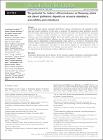The potential for indirect effects between co-flowering plants via shared pollinators depends on resource abundance, accessibility and relatedness
| dc.contributor.author | STOUT, JANE | en |
| dc.contributor.author | POWER, EILEEN | en |
| dc.contributor.author | POWER, EILEEN | en |
| dc.contributor.author | STOUT, JANE CATHERINE | en |
| dc.date.accessioned | 2014-10-20T11:54:39Z | |
| dc.date.available | 2014-10-20T11:54:39Z | |
| dc.date.issued | 2014 | en |
| dc.date.submitted | 2014 | en |
| dc.identifier.citation | Carvalheiro L, Biesmeijer J, Benadi G, Fruend J, Stang M, Bartomeus I, Kaiser-Bunbury C, Baude M, Gomes S, Merckx V, Baldock K, Bennett A, Boada R, Bommarco R, Cartar R, Chacoff N, Danhardt J, Dicks L, Ekroos J, Henson K, Holzschuh A, Junker R, Lopezaraiza-Mikel M, Memmott J, Montero-Castaño A, Nelson I, Petanidou T, Power E, Rundlöf M, Smith H, Stout JC, Temitope K, Tscharntke T, Tscheulin T, Vila M, & Kunin WE, The potential for indirect effects between co-flowering plants via shared pollinators depends on resource abundance, accessibility and relatedness, Ecology Letters, 17, 2014, 1389-1399 | en |
| dc.identifier.other | Y | en |
| dc.identifier.uri | http://hdl.handle.net/2262/71593 | |
| dc.description | PUBLISHED | en |
| dc.description | DOI: 10.1111/ele.12342 | en |
| dc.description.abstract | Co-flowering plant species commonly share flower visitors, and thus have the potential to influence each other's pollination. In this study we analysed 750 quantitative plant–pollinator networks from 28 studies representing diverse biomes worldwide. We show that the potential for one plant species to influence another indirectly via shared pollinators was greater for plants whose resources were more abundant (higher floral unit number and nectar sugar content) and more accessible. The potential indirect influence was also stronger between phylogenetically closer plant species and was independent of plant geographic origin (native vs. non-native). The positive effect of nectar sugar content and phylogenetic proximity was much more accentuated for bees than for other groups. Consequently, the impact of these factors depends on the pollination mode of plants, e.g. bee or fly pollinated. Our findings may help predict which plant species have the greatest importance in the functioning of plant–pollination networks. | en |
| dc.format.extent | 1389-1399 | en |
| dc.language.iso | en | en |
| dc.relation.ispartofseries | Ecology Letters | en |
| dc.relation.ispartofseries | 17 | en |
| dc.rights | Y | en |
| dc.subject | plant–pollinator network | en |
| dc.subject | phylogenetic distance | en |
| dc.subject | nectar | en |
| dc.subject | morphological similarity; | en |
| dc.subject | interspecific competition | en |
| dc.subject | indirect interactions | en |
| dc.subject | flower resources | en |
| dc.subject | flower density | en |
| dc.subject | floral traits | en |
| dc.subject | Facilitation | en |
| dc.title | The potential for indirect effects between co-flowering plants via shared pollinators depends on resource abundance, accessibility and relatedness | en |
| dc.type | Journal Article | en |
| dc.type.supercollection | scholarly_publications | en |
| dc.type.supercollection | refereed_publications | en |
| dc.identifier.peoplefinderurl | http://people.tcd.ie/stoutj | en |
| dc.identifier.peoplefinderurl | http://people.tcd.ie/powerei | en |
| dc.identifier.rssinternalid | 96606 | en |
| dc.identifier.doi | http://dx.doi.org/10.1111/ele.12342 | en |
| dc.rights.ecaccessrights | openAccess | |
| dc.subject.TCDTheme | Smart & Sustainable Planet | en |
| dc.subject.TCDTag | Biodiversity | en |
| dc.subject.TCDTag | Biodiversity and Conservation | en |
| dc.subject.TCDTag | Ecology | en |
| dc.identifier.rssuri | http://onlinelibrary.wiley.com/doi/10.1111/ele.12342/abstract | en |
Files in this item
This item appears in the following Collection(s)
-
RSS Feeds
-
Botany (Scholarly Publications)
Botany (Scholarly Publications)




